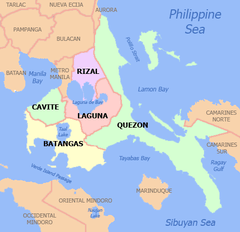Carmona, Cavite
| Municipality of Carmona Bayan ng Carmona | ||
|---|---|---|
| Municipality | ||
|
Carmona welcome sign | ||
| ||
| Nickname(s): Center for Investment & Sports; Industrial Corridor of Cavite; Sorteo Capital of the Philippines | ||
| Motto: Bayan Muna Lagi (Town Always First) | ||
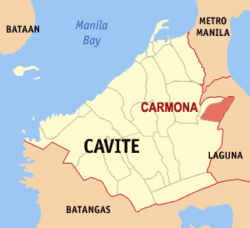 Map of Cavite showing the location of Carmona | ||
.svg.png) Municipality of Carmona Location within the Philippines | ||
| Coordinates: 14°19′N 121°03′E / 14.317°N 121.050°ECoordinates: 14°19′N 121°03′E / 14.317°N 121.050°E | ||
| Country | Philippines | |
| Region | CALABARZON (Region IV-A) | |
| Province | Cavite | |
| District | 5th District of Cavite | |
| Founded | 16th century | |
| Incorporated | February 20, 1857 | |
| Barangays | 14 | |
| Government[1] | ||
| • Type | Sangguniang Bayan | |
| • Mayor | Dahlia A. Loyola (LP) | |
| • Vice Mayor | Elmer M. Reyez (LP) | |
| • Town Council | ||
| Area[2] | ||
| • Total | 40.24 km2 (15.54 sq mi) | |
| • Land | 30.92 km2 (11.94 sq mi) | |
| Highest elevation | 87 m (285 ft) | |
| Lowest elevation | 38 m (125 ft) | |
| Population (2015)[3] | ||
| • Total | 97,557 | |
| • Density | 2,203/km2 (5,710/sq mi) | |
| Demonym(s) | Taga-Carmona | |
| Time zone | PST (UTC+8) | |
| ZIP code | 4116 | |
| Dialing code | +63 (0)46 | |
| Languages | Tagalog, Chavacano, and English | |
| Income class | 1st Class | |
| Website |
carmonagov | |
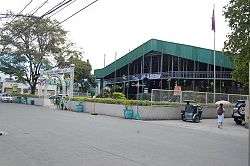
The Municipality of Carmona (Filipino: Bayan ng Carmona) is a first class urban municipality in the province of Cavite, Philippines. According to the 2015 census, it has a population of 97,557 people[3] in a land area of 30.92 square kilometres (11.94 sq mi).
Geography
Carmona is located on the south-eastern part of the province of Cavite, approximately 36 kilometres (22 mi) south of Manila and 24 kilometres (15 mi)[4] from Trece Martires City, Cavite’s provincial capital. It is bounded on the north, east and south by the City of Biñan, Laguna, Municipality of General Mariano Alvarez (GMA) on the north-west and Silang on the south-west. The geographic coordinates of Carmona are about 14.32° latitude and 121.06° longitude.
Land area
With a total land area of 3,092 hectares or 30.92 square kilometers, Carmona represented 2.17% of the total land area of the province. These areas are currently occupied by 14 barangays of which 7 are considered Poblacion barangays and 7 others are regular barangays. Barangay Lantic is the largest area while Barangay 2 has the smallest area.[5][6]
|
|
Topography
The topography of Carmona is generally flat to strongly rolling or sloping, partly lowland and partly hill. Carmona is divided into four physiographical areas: the lowest lowland area, the lowland area, the central hilly area and the upland mountainous area.[7]
- The lowest lowland area is generally flat plain. This area comprises the Barangay Maduya and a small portion of Cabilang Baybay.
- The lowland area consists of the flat plains and valley areas where there are parts that are not even ground. The area can be found in Poblacion 1 through 8, and in a small portion of Lantic, Milagrosa, Cabilang Baybay and Mabuhay.
- The central hilly area is generally found on the mountain foothills. It forms the rolling tuffaceous plateau. This topography includes steep hills, ridges and an elevated inland valley. This area comprises the rest of Barangay Milagrosa, a small portion of Barangay Cabilang Baybay and the middle portion of Barangay Mabuhay and Lantic.
- The upland mountainous area is the hilly and mountainous area. This area comprises the western part of Carmona including the Barangay Bancal and the rest of Barangay Mabuhay and Lantic. It is situated at a very high elevation.
Slope
The first slope of the municipality is 0-3%; broad to level or nearly level is classified as under 0-3% slope. This is generally the flat plain level lands of the Barangay Maduya.
The second slope, ranging from 3 to 8%, is gently sloping areas with land sloping, gently undulating and rolling. This area comprises Poblacion 1 through 8, and also a portion of Cabilang Baybay with a small portion of Barangays Milagrosa and Mabuhay.
In the central area of the municipality is a slope ranging from 8 to 18%. This area comprises the rest of Barangay Milagrosa, a small portion of Barangay Cabilang Baybay and the middle portion of Barangay Mabuhay and Lantic.
And the last slope of municipality ranges from 15% to more than 40%. This area comprises the western part of Carmona including the Barangay Bancal and the rest of Barangay Mabuhay and Lantic.[7]
Water resources
Inland water bodies serve as natural boundaries with neighboring municipalities and drain its surface waters towards Manila Bay and Laguna Bay. These are the San Gabriel River on the eastern boundaries with GMA, Cavite and Carmona River on the western boundaries with Biñan, Laguna.
The hydrological network of the town is composed of main rivers and tributaries. It also has springs, waterfalls and artesian wells. Deep wells provide water supply for both domestic and irrigation purposes.
Elevation
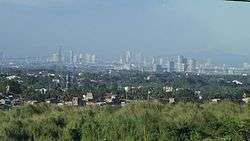
Carmona is an elevation of about 38 to 87 meters or 125 to 285 feet above sea level. The lowest elevation is Barangay Maduya, while the Poblacion Areas (Barangay 1–8), Barangay Cabilang Baybay, the northern part of Mabuhay, Milagrosa and Lantic are at an average elevation, the southern part of Milagrosa is situated at a higher elevation, and Barangay Bancal and the rest of Barangay Mabuhay and Lantic are situated at a very high elevation.[8]
Fault line
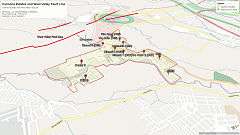
Carmona is included in the Valley Fault System. The line of the Valley Fault System starts from the Sierra Madre and passes through in this town.[9][10]
Climate
Carmona has a Type I climate characterized by two pronounced seasons: dry from November to April and wet during rest of the year. Maximum rainfall usually occurs from June to September. The average annual rainfall is 200 millimeters with a peak of 400 millimeters in August.
The average annual temperature is 27.2 C. The highest temperature occurs during the month of May while the lowest occurs during the month of January.
The predominant wind direction comes from the south-west during the month of June to September and from the north-west during the month of October to January, while from February to April, the wind is coming from the southeast, predominantly in the month of May.
The average humidity of Carmona is 81%. This makes the municipality cooler than the Metropolitan Manila Area where the average humidity is higher.
| Climate data for Carmona Cavite, Philippines | |||||||||||||
|---|---|---|---|---|---|---|---|---|---|---|---|---|---|
| Month | Jan | Feb | Mar | Apr | May | Jun | Jul | Aug | Sep | Oct | Nov | Dec | Year |
| Average high °C (°F) | 29 (84) |
29 (84) |
31 (88) |
32 (90) |
33 (91) |
31 (88) |
30 (86) |
30 (86) |
30 (86) |
30 (86) |
30 (86) |
29 (84) |
30 (86) |
| Average low °C (°F) | 23 (73) |
23 (73) |
24 (75) |
25 (77) |
26 (79) |
25 (77) |
25 (77) |
25 (77) |
25 (77) |
25 (77) |
24 (75) |
24 (75) |
24 (75) |
| Average precipitation mm (inches) | 1.3 (0.051) |
0.5 (0.02) |
0.9 (0.035) |
1.9 (0.075) |
12.1 (0.476) |
25.1 (0.988) |
29.4 (1.157) |
41.6 (1.638) |
33.8 (1.331) |
15.4 (0.606) |
11.1 (0.437) |
5.3 (0.209) |
178.3 (7.02) |
| Source: http://www.weatherbase.com/weather/weather.php3?s=984280&refer=&units=metric | |||||||||||||
Soil properties
The eastern side of Cavite consists of Carmona clay loam with streaks of Carmona clay loam steep phase and Carmona sandy clay loam. This type of soil is granular with tuffaceous material and concretions. It is hard and compact when dry, sticky and plastic when wet. This type of soil is planted with rice with irrigation or sugarcane without irrigation. Fruit trees such as mango, avocado and citrus are also grown in this type of soil.[7]
Mineral resources
Cavite coastal areas have marl and conglomerate sedimentary rocks and some igneous rocks which are prominent in the high, mountainous regions of the western part of the province. Carmona reserves and deposits of sand, clay and gravel materials are found in Sitio Ulong Tubig, Mabuhay.[7]
Demographics
| Population census of Carmona | ||
|---|---|---|
| Year | Pop. | ±% p.a. |
| 1903 | 2,606 | — |
| 1918 | 2,818 | +0.52% |
| 1939 | 5,394 | +3.14% |
| 1948 | 5,597 | +0.41% |
| 1960 | 8,212 | +3.25% |
| 1970 | 16,123 | +6.97% |
| 1980 | 21,014 | +2.69% |
| 1990 | 28,247 | +3.00% |
| 1995 | 35,686 | +4.48% |
| 2000 | 47,706 | +6.42% |
| 2007 | 68,135 | +5.04% |
| 2010 | 74,986 | +3.55% |
| 2015 | 97,557 | +5.14% |
At present, Carmona has a rapid growth of population; it increased a thousandfold from its population history. In the mid-1990s to 2001, it bloomed to 53,650.
Carmona has a total population of 74,986 which represents a total number of households at 14,885 in the 2010 census.[11]
Population density
The population density of Carmona is 17.35 per hectare. This estimated figure is much higher than the year 1995 with only 11.54 persons per hectare. The highest densities are found in the Poblacion area (Barangays 1–8) and Barangays Milagrosa and Maduya, where land areas are significantly lower than the other barangays. Barangay Lantic posted development of the Kuok Property within the Lantic area; it is expected that the density will increase within the ten-year period.[11]
Population distribution
Carmona's population is concentrated in Barangays 1-8 at the Poblacion area. Brgy. Milagrosa is the most populated barangay, which posted a total population of 15,284. Dense population is also found in Brgy. 9, the central business district of the municipality. Most population catalysts such as banks, town center, and commercial establishments are found in the Poblacion area.[11]
Demographics per barangay
According to the 2010 census, it has a population of 74,986 people in a land area of 40.24 square kilometres.
| Barangay | Population[3] | Households | Families |
|---|---|---|---|
| Poblacion 1- San Pablo | 2,696 | 608 HHs | 648 |
| Poblacion 2- San Jose | 461 | 114 HHs | 458 |
| Poblacion 3- San Jose | 525 | 129 HHs | 519 |
| Poblacion 4- JM Loyola | 542 | 140 HHs | 135 |
| Poblacion 5- JM Loyola | 581 | 168 HHs | 167 |
| Poblacion 6- Magallanes | 593 | 136 HHs | 140 |
| Poblacion 7- Magallanes | 575 | 129 HHs | 134 |
| Poblacion 8- Rosario | 2,640 | 633 HHs | 646 |
| Maduya | 7,961 | 1,804 HHs | 1,866 |
| Cabilang Baybay | 6,072 | 1,425 HHs | 1,470 |
| Mabuhay | 8,772 | 1,941 HHs | 2,294 |
| Milagrosa | 20,454 | 4,475 HHs | 4,681 |
| Lantic | 4,066 | 969 HHs | 3,492 |
| Bancal | 8,570 | 2,214 HHs | 3,696 |
| Total | 64,508 | 14,885 | 20,346 |
Language
The main language spoken is Tagalog. In some areas they speak Chabacano or Chavacano, sometimes referred to by linguists as Philippine Creole Spanish, a Spanish-based creole language spoken in the Philippines. English is considered as the second language and is widely used as medium of communication in business and higher education. Other Philippine languages spoken are Waray, Bicolano, Cebuano, Ilokano, Pangasinense, and Hiligaynon. Chinese and Spanish are also spoken by some local residents.
Religion
Roman Catholicism is a fast-growth church throughout Carmona. Iglesia ni Cristo, Baptist, Adventist, Jehovah's Witness, LDS Churches, Protestant/Christian churches, Islam, born again Christian fellowships (Jesus Is Lord, Victory, Word for the World, Community Harvest, Community of Praise, Jesus Christ Spreading the Good News, Lord's Vineyard Covenant Community etc.) and Members Church of God International (Ang Dating Daan) are also established in two Baranggay's.
| Religion | Percent ( % ) |
|---|---|
| Roman Catholic | 90.81% |
| Protestant | 1.23% |
| Members Church of God International | 2.3% |
| Aglipay | 0.11% |
| Islam | 0.11% |
| Iglesia ni Cristo | 1.5% |
| Others (specified) | 2.84% |
| None | 0.17 |
Registered voters
There are 38,105 registered voters in Carmona (2009 COMELEC) out of a total Carmona population of 74,986 (as of the May 1, 2010 census).
History
Carmona was just a part of the big town of Silang. This is not surprising because in the early part of the Spanish regime Silang included what today are known as the municipalities of Indang: San Francisco de Malabon (now General Trias), and Maragondon. Moreover, Alfonso, Amadeo, and Mendez were mere sitios of Indang; Sta. Cruz de Malabon (now Tanza) was a part of San Francisco de Malabon or Malabon Grande; and Magallanes and Ternate were barrios of Maragondon. Furthermore, Maragondon itself had been a part of the Corregimiento of Mariveles on the opposite side of Manila Bay.
According to research conducted in 1982, by Sangguniang Bayan members Ernesto Zamora, Salvador P. Manahan, Pio Purificacion, Narciso Levardo, and Romy Laurito, assisted by Municipal Secretary Rogelio D. Paular, it was found out that the history of Carmona began during the 15th century. As related by a reliable informant, three brothers coming from the mountain of Silang were said to be the first settlers in the place which was then called “Latag”, a Tagalog word for “plain” due to the numerous hills and plains in the area. The settlement was not known to other residents of Silang until some of them also went down to the place, cleared some forest areas and established their residence.
In 1595, Silang became a town and Latag was annexed as a part since then. Latag gradually developed into a community whose residents struggled hard to make it a town. Their burning desires were filled with hopes and fulfillment in 1856 when their move for the conversion of Latag into a town was spearheaded by a leader named Tiburcio Purificacion. Finally, by virtue of a decree issued on February 20, 1857 by the King of Spain through Governor General Fernando de Norzagaray, Latag became a separate municipality with the name it bears today: Carmona, named after the town of Carmona in the province of Seville, Spain. Yet until now, it had not been known where the name originated.
During the Philippine Revolution in 1896, the gobernadorcillo of Carmona was Kapitan Damian Ermitano after the administrations of Tiburcio Purificacion, Mariano Mapanoo and Donald C. Virtucio, Augusto Manaog and Fabian Tenedero.
After the revolution and the occupation of the country by the Americans in 1901, the first local executive of Carmona was Martin Reyes who was followed next by Marcelo Reyes, Prudencio Torres, Juan Alumia, Estanislao Paular, Marciano Mapanoo, and Juan Zamora.
The mayors who assumed office after World War II were the following honorable men: Bernardo Hebron, Eulalio Reyes and Cesar Casal and Felino L. Maquinay. In 1959, the district of San Gabriel and San Jose of Barangay Kabilang Baybay was purchased by the National Government for the relocation of squatters from Metro Manila. On March 14, 1981, the relocation site, which teemed with people from almost every part of the country and was more popularly known as the resettlement area, became an independent municipality called General Mariano Alvarez.
Timeline of Carmona
- 1500–1600 → Carmona history started with three brothers that came to the land of Carmona that was at that time called Labac.
- 1595 → Silang became a town; the former Sitio Labac became Barrio Latag.
- March 9, 1746 → They determined the boundaries of Silang and Biñan under a decree signed by Mayor Pedro Calderon Enriquez.
- November 15, 1759 → Two years after securing the independence of Carmona, the principales requested the Governor of Cavite for the reversal of the Canon on communal lands after constructing their own public buildings and irrigation works.
- 1838 → The movement of the inhabitants of Latag to become a town started.
- February 20, 1857 → Because of the great distance to the mother town, the principales and incumbent Cabeza de Barangay of Latag petitioned for its separation and conversion into a municipality. The new town was called Carmona, after a town of the same name in the Spanish province of Seville.
- April 16, 1857 → They set the boundaries of Silang and Carmona.
- September 15, 1859 → The inhabitants of Carmona returned to managing and ownership of communal lands.
- January 22, 1864 → The incumbent gobernadorcillo and principales of Carmona petitioned higher authorities for the abolition of the repartimiento of the communal lands triennially.
- 1872 → The communal lands were sold at public auction, which was opposed two years later by Don Gaspar Espiritu in a communication to the Superior Civil Governor.
- October 25, 1874 → An event of great significance to the people of Carmona was a strong typhoon, which wrought considerable damage to the public works and private property.
- July 6, 1881 → Seven years later, the principales of Carmona requested the rectification of the town’s boundaries.
- 1941 → The inhabitants of Carmona renewed the demand for "homestead" land.
- 1959 → The district of San Gabriel and San Jose of Barangay Cabilang Baybay was purchased by the National Government for the relocation of squatters from Metro Manila.
- March 14, 1981 → The relocation site, which teemed with people from almost every part of the country and was more popularly known as resettlement area, became an independent municipality called General Mariano Alvarez.
Former municipal mayors
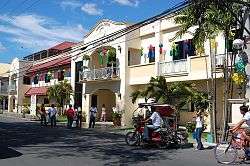
- Mayors:
- Marcelino P. Clarito
- Marcelo Reyes
- Martin Reyes
- Prudencio Torres
- Marcelo Reyes (re-elected)
- Juan R. Alumia
- Estanislao G. Paular (1931–1937)
- Marciano Mapanoo (1938–1941)
- Candido G. Hebron (1942–1943)
- Juan Zamora (1943–1944)
- Alfredo Anulat (1944–1945)
- Arsenio Mapalad (1945–1946)
- Bernardo B. Hebron (1946–1955)
- Eulalio Reyes (1955–1956)
- Cesar E. Casal (1956–1979)
- Felino L. Maquinay (1980–1986)
- Estelito Torres (OIC, 1986–1988)[12]
- Felino Maquinay (1988 – February 1990)
- Rolando Rosas (February 1990 – 1995)
- Roy M. Loyola (1995–2004; 2007–2010)
- Dahlia A. Loyola (2004–2007; 2010–present)
Barangays
Carmona is politically subdivided into 14 barangays. Eight of the current barangays are classified as poblacion barangays and the six others are ordinary barangays or barrios.[5]
Poblacion
Eight of the current barangays are classified as poblacion barangays, or those that are within the municipality's central area:
- Poblacion 1 – San Pablo (Barangay 1). This is also known as "Tabing Ilog" because in the left part of the barangay is a river. It is in the middle-west part of Carmona.
- Land Area: 17.9 square kilometers
- Nickname: Town Proper of the Municipality
- Poblacion 2 – San Jose (Barangay 2). This is the outskirts of the town proper. It is in the middle-west part of Carmona.
- Land Area: 5.84 square kilometers
- Nickname: Town Proper of the Municipality
- Poblacion 3 – San Jose (Barangay 3). This is the way going to the Barrio of Milagrosa. It is in the middle-east part of Carmona.
- Land Area: 5.61 square kilometers
- Nickname: Town Proper of the Municipality
- Poblacion 4 – J.M. Loyola (Barangay 4). Located here are the Municipal Hall, Town Plaza and the Independent Church of Carmona. It is in the middle-west part of Carmona.
- Land Area: 5.61 square kilometers
- Nickname: Town Proper of the Municipality
- Poblacion 5 – J.M. Loyola (Barangay 5). This is also known as "Real". This is the way going to Barrio Mabuhay. It is in the middle-east part of Carmona.
- Land Area: 4.25 square kilometers
- Nickname: Town Proper of the Municipality
- Poblacion 6 – Magallanes (Barangay 6). Located here is the Colegio de San Jose. It is in the middle-west part of Carmona.
- Land Area: 5.5 square kilometers
- Nickname: Town Proper of the Municipality
- Poblacion 7 – Magallanes (Barangay 7). This is also known as "Tabing Bukid" because in the right part of the barangay is a farm. It is in the middle-east part of Carmona.
- Land Area: 3.6 square kilometers
- Nickname: Town Proper of the Municipality
- Poblacion 8 – Rosario (Barangay 8). Located here are the Carmona Elementary School and Carmona National High School. It is in the middle-east part of Carmona.
- Land Area: 13.69 square kilometers
- Nickname: Town Proper of the Municipality
Barrios
Six of the current barangays are classified as ordinary barangays or barrios, those that have a civilization of their own and well-organized independent villages.
- Maduya (Barangay 9). The forefront barangay of Carmona from Metro Manila. Located here is the exit going to the South Luzon Expressway and going to the Province of Laguna. Located in the eastern part of downtown.
- Land Area: 182.0 square kilometers
- Nickname: Central Business District of the Municipality
- Maduya is the largest barrio in the municipality of Carmona. It is in the eastern part of town with a kilometer length of the national highway towards Biñan, Laguna, going through. It seems to be plains, and farming is the main occupation of its inhabitants.
- History: In the beginning, Maduya was only one sitio of Barrio Latag, with only five houses standing inhabited by twelve families. Since Carmona became a municipality, the sitio became a barrio. The term Maduya came from "Maruya", a bread from ground rice (rice flour) with a sliced saba banana, fried together and served as snacks. Most inhabitants cooked it and peddled it around town, shouting "Maruya". Eventually the shout of "Maruya" became "Maduya", which became the name of the barrio.[13]
- Cabilang Baybay (Barangay 10). Located in the central-east of downtown. Located here are the Old Cemetery of the town and the Manila Southwoods Golf and Country Club.
- Land Area: 315.0 square kilometers
- Nickname: Nayon ng Cabilang Baybay
- History: During the Spanish era, this was the only sitio inhabited by some families. Their homes were only huts, and farming was their living. In the beginning there was no city name. To have a name, the Cabeza de Barangay appeared in court and suggested calling it Cabilang Baybay, as it is on the shore of the river, and on its other side is a field. The request was then adopted by the Governor. General Leonard Wood.
- Mabuhay (Barangay 11). Located in the west of the downtown. Located here is one of the biggest commercial subdivisions in town, the Macaria Business Park.
- Land Area: 245.0 square kilometers
- Nickname: Central of Commercial-Business District of the Municipality
- History: During the Commonwealth era, Bagong Bayan (former name of Mabuhay) was established. Seven families settled here on the west side of Carmona.
- In 1938, the provincial highway was built here and on towards the town of Silang, which promoted the lifestyle of the people. It motivated the people of nearby barrios to come to this place. Most residents are living by farming and in the nearby hills. After the war, the municipal council changed the name of the barrio to "Barrio Mabuhay", which means new life or progress.
- Milagrosa (Barangay 12). Located in the south-west of the downtown. Barangay Milagrosa is the most populated barangay.
- Land Area: 70.0 square kilometers
- Nickname: Most Populated Barangay of the Municipality & Historical Barrio of the Municipality
- History: There are seven of hectares of land in the south-west of downtown; this is the historical Barrio Milagrosa. This place was formerly part of the vast land of Yaptinchay of Biñan, Laguna. The understanding of those living there, was that the hacienda was part of Carmona before 1935. The people started to try to return ownership to the people of Carmona. They built the organization called "Samahang Pagkakataon Na", under the leadership of then-Mayor Mapanoo Marciano. Many predicted that the association would be disappointed, but the people had a strong commitment. In 1938, led by Mayor Mapanoo and G. John Alumia, including three truck people, they went to the Malacañang Palace to ask President Quezon for permission. The president listened carefully, and once again proved his awareness of the emerging social justice. After the Second World War, the land was divided and given to the landless. This area is named the "Milagrosa" because the returning of the land to the local people is a "Milagro" ("miracle").
- Lantic (Barangay 13). The biggest barangay of Carmona, where most of the land here is farm. Located here is the famous residential-community Canyon Ranch and the Carmona Estates, and the first "racino" facility in Asia, Manila Jockey Club (San Lazaro Leisure & Business Park).
- Land Area: 1,698.0 square kilometers
- Nickname: Central of Agricultural District of the Municipality
- History: The west of downtown is the Barrio Lantic in Carmona. According to the adults in this area, the area was previously wild. Some from Silang decided to clean up this place and build houses in this area. Later, they had agreement to give a name to this barrio. Some wanted a name starting with the letter "L", to match the shape of the houses. Others preferred "Pinaglantikan". They compromised on "Lantic".
- Bancal (Barangay 14). The furthest barangay of Carmona. Located here is the Carmona Racing Circuit.
- Land Area: 520.0 square kilometers
- Nickname: The Upland Area of the Municipality
- History: More time passed, but the area was still mostly forest. Most of the trees are called "Bancal". It is yellow wood, efficient for building houses and for firewood. Almost all residents have houses made of Bancal. During the Japanese Occupation, the people living here cut the wood to make firewood, and sold it in the bakery. Because of the importance of the wood, the barrio is called Bancal.
Sitio
A sitio is a territorial enclave that forms part of a barangay, the location of which may be distant from the center of the barangay itself. Only partial knowledge is available about the sitios of Carmona, but patiently researching some information revealed the following:
- Kay Impierno: It is known as "Paligawang Bayan" because almost all the animals in the town and surrounding barrios were fed there.
- Paligawang Matanda: It also served as pasture but not as much as Kay Impierno.
- Paligawang Bata: It also served as pasture but not as much as Kay Impierno.
- Ulong Tubig: Means water sources. The sitio is at the foot of the mountain. A huge fountain brings plenty of irrigation water for rice fields. The fountain has been organized, and serves as a swimming pool that attracts tourists.
- Pinagdabilan: This place was formerly a popular place for the plunder of thieves. An incident occurred here which gave the sitio its name. One night, an old man brought a guitar called "Ravel", playing music across the mountains, and he met a group of bandits. They saw his guitar "Ravel". One of the robbers took it, played it, and ordered the old man to dance. When the old man grew tired, other old men played the guitar, and they in turn danced. Suddenly more elderly arrived. When the thieves saw they were greatly outnumbered, they hurriedly left. After that this place was called "Pinagravelan", and later was called Pinagdabilan.
- Pasong Buhangin: It is a river that has served people clean water, because of many springs on the riverside.
- Agiit
- Pasong Tuko
- Pasog Kabayo
- Pasong Emang
- Pasong Saging
- Pasong Pari
- Patindig Araw
Landmarks
Here are some of Carmona's landmarks:
Religious and historical sites
The people of Carmona actively participated in the revolution against the Spaniards. Carmona also witnessed the Filipinos’ resistance against the Japanese forces. During the Japanese occupation, some of Carmona’s prominent houses were used as Japanese headquarters while the hills became the stronghold of Filipino revolutionaries.
Like other towns, Carmona also has historical sites and buildings related to wars. Only a few were during the Spanish period. Most of the historical events were during World War II.[14]
- Fuente (big irrigation dam) – Patubig 1900: Conference of the Spanish Cacedores.
- Simbahang Kastila – April 1800: Built during the Spanish Reign and then became the center of the sona during the Japanese occupation.
- Bahay ni Estanislao Paular – 1941–1945: The Niponggo (Japanese) official office in the Second World War.
- Bahay ni Alkalde Juan Zamora – 1940–1945: The office of the Japanese leaders.
- Carmona Elementary School (Gabaldon Type) – 1941–1945: The temporary hospital for the citizens.
- Glorietta – 1942: Destroyed during the Japanese occupation.
- Carmona Cemetery – libingan bayan – 1941–1945: The slain were buried here during the Japanese occupation.
- Carmona Elementary School (Gonzales Type) – 1941–1945: Served as hospital of the guerrillas and the residents of Carmona.
Natural attractions
- Ulong Tubig Pool – The spring water comes from an adjacent hill in the area, located in Sitio Ulong Tubig, Barangay Mabuhay. This also serves as a source of irrigation for farmers in Carmona. It is a pool formed by natural spring water emanating from the adjacent hill. The pool leads to an irrigation pump, which supplies a vast number of rice fields in Carmona. The area is shaded by coconut trees and other greenery. In the morning, the water appears to be very clear. However, in the afternoon, it changes to a green hue due to algae disturbed by the swimmers.
- Pasong Buhangin River – One of the cleanest and greenest bodies of water in Cavite. Located in Sitio Pasong Buhangin, Barangay Lantic.
Sports attractions
- Manila Southwoods Golf and Country Club – Located at Southwoods Avenue, Barangay Cabilang Baybay. This exclusive club caters mostly to local and international golfers. The 18-hole golf course was designed by the world-renowned golfer Jack Nicklaus and developed by the Fil-Estate Development Corporation. Not only does this place attract a number of tourists, but it is also a venue for private and government-sponsored meetings and workshops.[15]

- San Lazaro Leisure & Business Park – Located in Barangay Lantic. A twin-oval P400 million horse racing track is the premier venue for the best horse races in the country. The horse races are always well-attended, with the promise of winning a large wad of cash. If you do get to win or just want to win more money, visit the nearby PAGCOR San Lazaro casino. The casino has the latest gambling machines in the country. If you do get hungry playing, you can also check the various gastronomic dining choices in the club. This is managed by the Manila Jockey Club.[16]
- Carmona Racing Circuit – Is the venue for most of the popular karting competition in the Philippines. Carmona Racing Circuit is a permanent motorbike racing and karting circuit outside Metro Manila. The track includes four alternative configurations (consisting of circuit distances from 1 km to 750 m). Located in Barangay Bancal.[17]
- Carmona Baseball Academy – The baseball field, located in Brgy. Lantic, consists of three baseball diamonds. G.E. & H Academy is committed to provide baseball training for free to the youth of Carmona in accordance with the sports program of the municipal government. The Baseball Educational Tour and Training started on February 2008. G.E. & H Academy donated baseball gear and equipment.[18]
- Carmona Firing Range – Located in Barangay Milagrosa near San Lazaro/Casino Filipino. Carmona Firing Range is managed by Carmona Cavite Integrated Shooters Gun Club (CCIS).
- Paragliding at Carmona – Located in the foothills in Barangay Lantic. It is a growing adventure sport that attracts people from all walks of life mainly because of the feeling of freedom it gives when you are soaring in the skies. Because of the two distinct windy seasons in the Philippines that allow for long, exciting flights along the country’s ridges and cliffs, paragliding can almost be done anywhere.
Recreational attractions
- Paseo de Carmona – A retail complex of Carmona launched in 2007. It is highly accessible to residents of surrounding communities. Paseo de Carmona is home to numerous enterprises ranging from business centers, banks and salons, fastfood chains and restaurants opened to compete for regular patronage for great-tasting food, to intimate folk jams and videoke. Paseo offers clean fun all night.
- Waltermart Carmona Branch – A shopping center located in Macaria Business Park Governor's drive Barangay Mabuhay. It is known for its proximity to Carmona Town Proper.
- Carmona Square – As in Paseo de Carmona, it also has fastfood chains etc. Located in Governor's Drive Corner of Cabilang Baybay. It is known for its proximity to Carmona town proper.
- Carmona Serenata 24/7 Entertainment Complex (U.C.) – An entertainment complex located in Macaria Business Park, Governor's Drive, Barangay Mabuhay.
Eco-tourism
- Carmona Organic Demo Farm – Located in Barangay Lantic. This farm was cited as a showcase of “good practice” in agriculture.
- Carmona Ecology Center – Located in Barangay Lantic. The Center was cited as a showcase of “good practice” in solid waste management in the country.
Resorts
- The Viewfort Venue – Viewfort is a fastidious resort, accommodation, and events venue located along Governor's Drive in Barangay Cabilang Baybay. With its landscaped and expansive gardens, this resort stands incomparable in beauty and service. The breathtaking views of Laguna Lake from the top of the hill will surely relax your eyes and body as well.
- Sylvia's Place – Located on Market Road Barangay Maduya.
- Municipal Pool – Located in the middle of the fields of Barangay Lantic and it is managed by the Local Government of Carmona.
- Villa San Pascual Resort - Located also in the middle of the fields of Barangay Lantic.
Other attractions
- Carmona Public Market (CPM) – Located on Market Road Brgy. Maduya, the only public market in the town was conceptualized in the latter part of 1995 Image, during the first term of the incumbent mayor as part of his efforts to boost the commercial status of the municipality. From its inception, the prime consideration in the design and construction of the public market is to emphasize its uniqueness. Other considerations were its accessibility to differently abled individuals and total shopping convenience for the patrons.
- Carmona Town Plaza – The Plaza and the central area of the town located in Brgy. 4 – J.M. Loyola at the Poblacion Area. Located here are Hon. Marciano Mapanoo Park, and the first parish in Cavite to have been dedicated to St. Joseph, St. Joseph Parish Church or Parroquia de Carmona, and the museum of Carmona, Museo de Carmona.
Economy
Cottage industries include metal works, metalcraft, footwear industries, concrete products, tricycle assembly, rattan handicrafts and bakeries. Manufacturing firms engaged in handicraft (bags and shoes), furniture making, business retailing, personal and business services, and food based enterprises contribute to the municipality’s trade and commerce. Mercantile activities in the municipality are concentrated at the Poblacion area and along Governor’s Drive. Carmona has been classified as a first class municipality since July 1996, brought about by industrialization, real estate development and commercial activities.
Carmona’s progress accelerated after the conversion of more than fifty hectares of farmlands into industrial areas in 1998. Garment industries, steel fabrication, microchips and semi-conductors, tool fabrication, bus assembly, bulb factories, die casting and other small and medium-scale industries currently operate in the municipality. These investments continue to provide local employment, generate export earnings, increase municipal revenues and serve as vehicles for technology transfer. Foreign investments are pouring in as export-oriented industries continue to flourish.
Employment rate: Out of a potential labor force of 24,918 (members 15 years old & above who are actively seeking for work), 98.03% are employed while 1.97% are unemployed. The presence of 8 industrial estates & 2 industrial compounds contribute largely to the high employment rate of the municipality.
Agriculture
The economy of Carmona is generally agricultural. Almost half of its total land area is devoted to agriculture.
In 2000, the total land area devoted to agriculture was 609 or roughly 19.60% of the total land area of Carmona, which is 3,902 hectares. 230 hectares are irrigated areas all of which are currently planted with rice and vegetables, 30 hectares are upland rice areas, 122.5 hectares are for diversified trees and crops, and the other 211.5 hectares are considered pasture land.
There are 217 farmers in the Municipality engaged in planting and farming. Crops and livestock farmers are distributed among 14 barangays of Carmona.
However, with the implementation of the CALABARZON growth area, the municipality of Carmona has slowly become an industrial enclave in the province. The advent of industrialization has threatened the agricultural base of Carmona. As of April 1999, land used for rice production has gone down; sugarcane plantation has decreased considerably and those land uses for other crops and vegetables totaled 84.5 hectares during the same year.
At present, the programs and services of the Department of Agriculture (DA) are focused on five priority programs: a sustained self-sufficiency program for rice and corn, strengthening of production market linkage, an acceleration of livelihood program, aggressive assistance to organizational development of farmers, and assistance to agriculture-related priority programs of other government agencies.
- Crop production
- The major crops produced in the municipality are lowland and upland rice and sugarcane. Other crops grown are corn, vegetables, root crops, and fruit trees.
- Fruits and vegetables production
- In 2000, an area covering some 23.5 hectares was planted with various crops and fruit trees. These yielded an estimated 444 metric tons of assorted products.
- Livestock and poultry production
- Livestock and poultry raising in the municipality are largely backyard family enterprises. Animals raised are generally for home consumption and an additional income source for the family. Total production of livestock and poultry in 1999 registered a head count of 7,907. Pigs raised both for human consumption or for breeding purposes are estimated at 1,675, while the equally popular poultry raising produced about 4,472 head. An estimated 1,013 head of cattle, 31 head of carabaos and 716 goats were also produced. Based on reports of the municipal Agricultural Officer, the total livestock and poultry production in the municipality is still below the sufficiency level for beef, pork meat and eggs.[19]
Industry
Industrialization in the '90s accounts for the rapid growth of Carmona's business community from an otherwise quaint agricultural town in the 1950s. Brought about by huge capital from the national government, the industrial complexes bolstered the increase of the municipality's revenues and the change in the people's lifestyle.
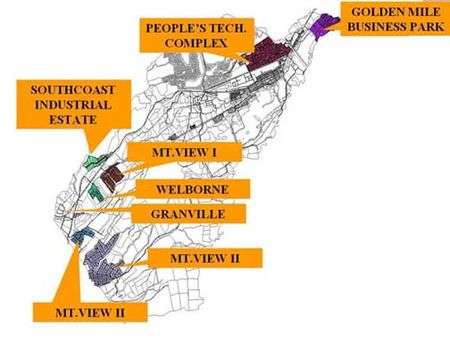
There are eight existing industrial complexes in the towns. Its proximity to Manila and at the same time being the gateway to the Calabarzon area made Carmona a promising venue for business.[20]
On the other hand, the local government has been very supportive of the investors. There are 114 factories in eight industrial parks/complexes to date. At present there are the eight industrial complexes strewn along the Governor's Drive, in a total of 419.31 hectares, making up 13.56% of the town's land area. Ranging from 9 to 100 hectares, these industrial estates are complete with amenities, secured, and in close coordination with the municipal government through the Carmona Business Club and other agencies.
Business
Carmona is composed of 975 commercial and business establishments. One is the Walter Mart Commercial Center situated at the Macaria Business Park which covers a land area of 13.13 ha.
Over 1100 duly registered commercial and financial establishments conduct trading, banking, servicing, settlements, recreation and entertainment.
Commercial and financial
One of the biggest commercial subdivisions in town is the Macaria Business Park in Barangay Mabuhay which houses Waltermart in its 13.13 hectare lot. Recently, fastfood chains and restaurants have been opened to compete for regular patronage at the Paseo de Carmona in Barangay Maduya.
Moreover, numerous traders and retailers are housed in the bustling Carmona Public Market.
The bulk of commercial activities come from wholesale/retail enterprises, which comprise a total of 619 establishments. There are also service-related establishments: businesses, food shops and amusement operators, with 35 banks and other lending institutions. Among the major banking institutions that cater to the financial needs of businesses in Carmona and neighboring towns are Bank of Philippine Islands (BPI), Metrobank, Banco de Oro (BDO), Chinatrust Bank, China Bank, RCBC, and Union Bank.
Events and festivals
Events
| Date | Event | Location |
|---|---|---|
| Every February 20 | Carmona Foundation Day | Carmona |
| February 16–22 (held every 3 years) | Carmona Sorteo ng Bukid Festival | Carmona |
| Every March 10 | Cavite Day | Cavite Province |
| Every March 19 | Carmona Town Fiesta | Town Proper |
| Every June 12 | Independence Day | Cavite Province / Philippines |
| Held every year | Carmona Trade Fair | Carmona |
Festivals
- Sorteo Festival
Carmona is the only municipality in the Philippines that observes a triennial draw of its communal lands among its locals – a practice that dates back to the country's Spanish colonization period. It is celebrated every 3 years from February 16 to 22.
After the war, Carmona started to find its path towards economic and political stabilization. During this period, the provision of a stable means of livelihood for all the people became top priority. Since Carmona was basically agricultural, the communal agricultural lands were offered to the farmers for cultivation through a lottery. This practice, held every three years, was locally known as "sorteo". Since then, "sorteo" has been embedded into the municipality's traditional procedures on land ownership. To this day, farm lots are being raffled off to interested farmers; lucky winners are awarded the right to till and develop a certain section of the communal lands. The traditional practice of "sorteo" defuses agrarian unrest and decreases tensions on land conflicts.
An age-old tradition celebrating the town as an agricultural haven is celebrated every 3 years. It is highlighted by an agro-industrial fair.
Sorteo events:
- Hataw Galaw, Indak-Sorteo (Street Dancing)
- Karosa ng Ani (Float Competition)
- Bahay Mo, Gayak Sorteo (House Decoration Contest)
- Barangay Mo, Gayak Sorteo
- Karakol sa Sorteo
- Gintong-Tinig, Gintong-Himig (Bulilit Portion)
- Gintong-Tinig, Gintong-Himig (Main Portion)
- Binibining Sorteo
- Drum and Lyre Band Competition
- Battle of the Bands
- Parangal sa Gintong Bukid
- Sorteo ng Bukid (Grand Lottery)
Places of worship
Parish church
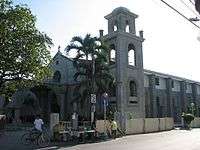
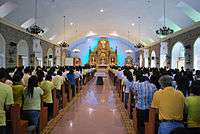
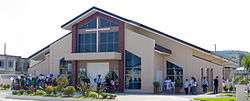
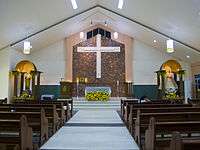
Saint Joseph, the spouse of Mary, has been one of the most popular patron saints in Cavite. This is attested by the fact that four parishes and numerous barangays of Cavite are dedicated to him.
Carmona was the first parish in Cavite to have been dedicated to St. Joseph. Originally, Carmona was a barrio of Silang. Its old name was Latag, a Tagalog word which means “plain.” The town (its barrios before) constituted a vast expanse of leveled land. This plain was cleared by settlers and became mostly rice fields. As a barrio, it was civilly and ecclesiastically under Silang.
Silang got into a conflict with the hacienda administrator of the Dominican Hacienda of Biñan. In this dispute, it seemed that the local leaders of Silang conducted themselves with great propriety and dignity. The Spanish government recognized this effort. So pleased was the King of Spain that when this honorable people sent a petition to the King, the latter did not hesitate to grant their request. On April 14, 1746, King Ferdinand VI issued a royal decree selling the land that was part of Silang comprising the barrio of Latag to the local principalia. Latag was acquired for the amount of two thousand Mexican pesos. Don Pedro Calderon (the oidor) and Don Alejo Aviles (the escribano (notary)) signed the document of sale in the King’s behalf while Don Bernabe Javier Manalo and Don Gervacio dela Cruz signed on behalf of the people of Silang. From that time on, a big portion of Latag became communal land where people could take turns in farming. It was a unique privilege given to them.
The Franciscans were the first to evangelize Silang and its neighboring towns like Indang and Maragondon. It is then safe to say that Latag may have been ministered to by the Franciscans, as well. However, in 1599, the Jesuits took over the administration of the parish in Silang. They became ardent propagators of the Christian faith. They went to the different parts of upland Cavite, building churches and teaching the faith. It was customary then that the Spanish religious priests concentrated their efforts in the poblacion. It was also customary practice to get Filipino secular clerics who would serve as assistants. They were usually sent to more difficult areas of the parish, usually far from where the center was. Although the road connecting Latag and Silang was bad, they said masses for the natives and baptized these natives’ children. The Filipino priest B. D. Eulogio Fabian is believed to have ministered to the people.
On February 20, 1857, the King of Spain through Governor General Don Fernando de Norzagaray created the new town of Carmona. Latag was renamed Carmona after the town in Seville, Spain.
By 1854, the administration of Silang was handed over to the Spanish Recollect friars. Imus and Dasmariñas were then haciendas owned by the Recollects and were under their spiritual care. From 1768 to 1857, the Filipino priest Eulogio Fabian took care of Latag. On December 15, 1857, the new town of Carmona became an independent parish with St. Joseph as its patron. Fr. Ramon Zueco de San Joaquin became its first Recollect parish priest. The Jesuits who were the former evangelizers must have been influential in choosing St. Joseph as patron of the new town and Our Lady of the Holy Rosary became its second patroness. A church made of stone and a massive convent was built.[21]
- Celebrate: March 19 (Carmona Town Proper)
Chapels
| Chapel | Patron | Celebrate | Location |
|---|---|---|---|
| Holy Rosary Chapel | Holy Rosary | October 7 | Brgy. Poblacion 8 |
| Seven Archangels Chapel | Seven Archangels | September 29 | Brgy. Maduya |
| St. Roch Chapel | St. Roch | August 16 | Brgy. Cabilang Bayabay |
| Risen Christ Chapel | Risen Christ | (Holy Week) Resurrection of Jesus Christ | Brgy. Mabuhay |
| Sacred Heart Chapel | Sacred Heart | 19 days after Pentecost | Brgy. Mabuhay – Cityland |
| Miraculous Medal Chapel | Miraculous Medal | November 27 | Brgy. Milagrosa |
| Immaculate Conception Chapel | Immaculate Conception | December 8 | Brgy. Milagrosa – Phase 3 |
| St. Isidore Chapel | Isidore the Laborer | May 15 | Brgy. Lantic |
| St. Augustine Chapel | St. Augustine | August 28 | Brgy. Bancal |
Other denominations
| Chapel/Church | Location |
|---|---|
| Iglesia ni Cristo | Brgy. Poblacion 7 |
| Jesus Is Lord Church | Brgy 11 Mabuhay |
| Carmona Christian Church | Brgy. Maduya |
| The Baptist Bible Church | Brgy. Milagrosa |
| Church of Jesus Christ of Latter-day Saints (Mormons) | Brgy. Maduya |
| United Methodist Church | Brgy. Cabilang Baybay |
| Word for the World Christian Fellowship | Brgy. Mabuhay |
| Members Church of God International | Brgy. Poblacion 2, Brgy. Bancal |
Seminary
| Seminary | Location |
|---|---|
| St. Gaspar Bertoni Seminary | Governor's Drive, Brgy. Mabuhay |
Education
The education sector in Carmona improved in many aspects of endeavor. In line with the local government's thrust of enhancing quality education, the Department of Education (DepEd), particularly the District of Carmona and Carmona National High School, with the full support of the local government unit, implemented various programs and projects that intensified the education sector in achieving its goals.
As early as 1995, various programs for the improvement of quality education started with a vision of producing competitive students from both the elementary and secondary levels. Carmona posted a literacy rate of 89%. The local government started with the computerization of all schools. Each public school was given computer units and students were provided with computer lessons. This is in consonance with the belief that modern technology and equipment are considered factors in enhancing better education. To address the increasing number of enrollees and students, the LGU conceptualized the construction of 2-story buildings in different schools in Carmona.
At present, the municipality has a substantial number of classrooms and teachers to meet the learning needs of the school age population. As of School Year 2005–2006, the municipality has 50 educational institutions, 28 of which are public schools while 17 are privately run. The public schools are categorized into 18 pre-schools, 9 elementary, 1 secondary, and 1 tertiary school. The private educational institutions are composed of 10 pre-schools, 7 elementary, 3 secondary/high school, and a computer college.[22]
- Public/private (tertiary)
- Cavite State University (Carmona Campus) – Market Road, Brgy. Maduya
- STI e-College Southwoods – Southwoods Avenue, Brgy. Maduya
- Imus Computer College Carmona Branch – Gov. Drive, Brgy. Maduya[23]
- Public (secondary)
- Carmona National High School – Barangay Poblacion 8
- Public (elementary)
- Carmona Elementary School – Barangay Poblacion 8
- Maduya Elementary School – Barangay Maduya
- Mabuhay Elementary School – Barangay Mabuhay
- Cabilang Baybay Elementary School – Barangay Cabilang Baybay
- Milagrosa Main Elementary School – Barangay Milagrosa
- Milagrosa West Elementary School – Phase 3, Barangay Milagrosa
- Lantic Elementary School – Barangay Lantic
- Bancal Elementary School – Barangay Bancal
- Paligawan Matanda Elementary School – Sitio Paligawan Matanda, Barangay Lantic
- Public (pre-school/day care)
- Carmona Elementary School (inside) – Barangay Poblacion 8
- Maduya Elementary School (inside) – Barangay Maduya
- Mabuhay Elementary School (inside) – Barangay Mabuhay
- Cabilang Baybay Elementary School (inside) – Barangay Cabilang Baybay
- Milagrosa Elementary School (Main) (inside) – Barangay Milagrosa
- Milagrosa Elementary School (West) (inside) – Barangay Milagrosa
- Lantic Elementary School (inside) – Barangay Lantic
- Bancal Elementary School (inside) – Barangay Bancal
- Rural Improvement Club Children Center (Under DA) – Barangay Poblacion 4
- San Jose Day Care Center – Barangay Poblacion 2
- Milagrosa Day CareCenter IV – Barangay Milagrosa
- San Roque Day Care Center – Barangay Cabilang Baybay
- Maduya Day Care Center – Barangay Maduya
- Mabuhay Day Care Center – Barangay Mabuhay
- San Agustin Day Care Center – Barangay Bancal
- Lantic Day Care Center – Barangay Lantic
- Private (pre-school/learning center/elementary/high school/college)
- Colegio de San Jose – Magallanes St, Barangay Poblacion 6
- Holy Christian Academy – Carmona Townhomes Barangay Milagrosa
- Children of Mary Immaculate School – Barangay Poblacion 1
- Cornerstone Christian Academy – Barangay Mabuhay
- Koramfil Christian School – Barangay Milagrosa
- Reyjoice Learning School – Barangay Mabuhay
- Carmona Christian School – Barangay Maduya
- Aranda Educational Institute – Governor's Drive, Barangay Bancal
- St. Anthony De Carmelli Academy – Carmona Estates, Barangay Lantic
- Beatitudes Technological & Theological College – Carmona Townhomes Barangay Milagrosa and Phase 4 Barangay Milagrosa
- Toddlers Smart Learning Center – Barangay Mabuhay
- Zion Academy – Barangay Mabuhay
- Kumon Learning Center – Macaria Business Center, Barangay Mabuhay
Social sector and services
Transportation
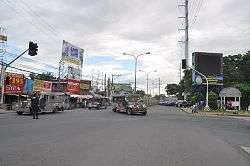
Carmona is accessible by various land-based transport vehicles from Manila and other nearby provinces and cities taking two alternative routes: South Luzon Expressway (SLEX) and the Cavite Coastal Road passing through Aguinaldo Highway and Dasmariñas/GMA Roads. It may be reached through public utility jeepneys and buses. It is a 15-minute drive from Alabang, Biñan, Laguna and GMA and 45-minute travel from Trece Martires City. A transport terminal was established in the Carmona Public Market for commuters going to Manila, Biñan and GMA. Ordinary and first class air conditioned buses coming from Biñan, Laguna use the National Road to pick up passengers in Carmona going to Manila.
Housing

The Municipality has a total population of 68,135 in 14,885 households. The Municipality has enough dwelling units for the residents. Most of the residents own their houses; some are renting (apartment type) and some are on the sharing arrangement basis. Almost all the households have basic amenities of comfortable living, equipped with modern appliances, conveniences of modern living and sufficient lighting facilities. The constituents have access to potable water.
- Canyon Ranch – Canyon Ranch is the only first-class, private residential community in the Philippines that is ideally complemented with exceptional terrain, location and climate. Located in Barangay Lantic.
- Carmona Estates – A subdivision managed by Property Company of Friends, Inc. or Pro-Friends. Located in Barangay Lantic. Subdivisions within Carmona Estates:
- Kinnari Village
- Pinecrest Village
- Amandala Village
- Cedar Village
- The Oaks Village
- Manila Southwoods Residential Estate – a subdivision inside Manila Southwoods. There is also a manor located there; this is Calabarzon’s first Philippines condominium-hotel infrastructure. Located in Southwoods Avenue, Barangay Cabilang Baybay.
- Other subdivisions and villages:
- Carmona Townhomes (Barangay Milagrosa)
- Villa Allegre Subdivision (Barangay Mabuhay)
- Woodland Hills (Barangay Bancal)
- Carmona Heights Subdivision (Barangay Mabuhay)
- Villa Sorteo (Barangay Milagrosa)
- Montecarlo Subdivision (Barangay Bancal)
- Altarez Village (Barangay Maduya)
- Macaria Village (Barangay Milagrosa)
- Hillside and Riverside Subdivision (Barangay Lantic)
Health services
Health is both means and an end of development. Improved health increases the productive capacity of the population. The Municipality of Carmona is expected to provide better facilities, services and personnel in specialized roles to promote, protect and maintain good health. The availability and access to health services are significant and contributory factors towards the attainment of good health.
The Pagamutang Bayan ng Carmona and the Rural Health Unit (RHU), both managed by the local government unit, cater to the medical needs of the residents of Carmona. The Pagamutang Bayan ng Carmona, manned by twenty-six (26) medical personnel, operates on a 24-hour basis (including drivers).
The primary function of the Pagamutang Bayan ng Carmona (PBC) is to render services to those who seek curative care. Aside from this, PBC also manages to work hand in hand with the Municipal Health Office (MHO) in promoting preventive medicine. In order to enhance the health population, the rural health units are undertaking immunization programs for the prevention of such diseases as tuberculosis, polio, diphtheria, tetanus, bronchopneumonia and measles, and the promotion of breast-feeding for infants. They are also conducting nutrition classes to lessen the occurrence of malnutrition especially among residents to prevent the rapid increase in population.
The main health center in the municipality is located in Barangay 4. A total of eleven barangay health centers or substations of the RHU are established in different barangays. In terms of health personnel, there are fifteen medical staff including 2 nurses and 11 midwives, 1 doctor and 1 medical technician.
In addition to the rural health units and the Pagamutang Bayan, there are also eleven private clinics operating in the municipality. Eleven clinics are privately owned and one clinic is under the supervision of government health workers.[24]
Peace and order
The local police force works in close cooperation with other PNP units and agencies both in the provincial and national level. Extending support to its efforts, the Carmona Traffic Management Office oversees road safety and regulations. Moreover, emergencies and fires are quickly responded to by the local Bureau of Fire Station with additional enforcements from other fire stations in Cavite.
Among the industrialized towns in Cavite, Carmona is considered the most peaceful. It has a very low crime rate at 7.15%, with a crime solution efficiency of 90%, despite the unfavorable policeman-to-population ratio of 1:1,788. This is made possible through the concerted efforts of the Carmona PNP, private volunteer groups, and organizations with the local government taking the lead.
Working hand in hand with the local government is the Bureau of Fire Protection which is always ready especially in times of disaster. It has widened its facilities by coordinating with the other BFP offices in the province.
Traffic in Carmona is generally smooth as there are deployed enforcers regulating traffic flow especially in choke points. This is handled by the Carmona Traffic Management Office.
Environmental management
The municipality is committed to work for economic growth without compromising ecological preservation and protection. This was reinforced with the establishment of the Municipal Environment and Natural Resources Office (MENRO) last 1997 to work hand in hand with the community and stakeholders towards the realization of harmonious coexistence with the environment.
Environmental Compliance of industrial establishments evidenced by their Environmental Compliance Certificates (ECCs), Wastewater Discharge Permits, Permit to Operate Air Pollution installations, integrated waste management, good housekeeping practices and the activities of their designated pollution control officers are monitored by the MENRO as part of its annual routine activity and basis for business permit evaluation. The office also offers technical assistance in order for industries to comply with the law at the minimum and set further goals for continuous improvement of environmental performance.
In 2002, Carmona won the coveted Gawad Galing Pook Award for excellence in good governance. Carmona Ecology Center was cited as a showcase of “good practice” in solid waste management.
Notable people
- Hospicio Hermosa – Also known as "Hopia", his power as unusual faith healer is believed to be a gift from God. Many spiritual phenomena are claimed.[25]
- Regino "Inong" Martillano and Emilia "Miyang" Martillano – a grandparent has the most grandchildren in Cavite along with 13 children, was the prime contender for a possible slot in the Guinness Book of World Records for having the most descendants at 130. The breakdown of Martillano's descendants count: 55 grandchildren, 78 great-grandchildren, and seven great-great-grandchildren as of 2014.
- Cherry Anne "Apple" Chiu – is a singer, one of the Philippine Idol Finalists among 12 aspiring singers who competed for Philippine Idol. She was eliminated on November 6.
- Susan Enriquez – is a Filipina broadcast journalist, reporter, host of GMA Network.
City twinning
References
- ↑ "Official City/Municipal 2013 Election Results". Intramuros, Manila, Philippines: Commission on Elections (COMELEC). 11 September 2013. Retrieved 30 October 2013.
- ↑ "Province: CAVITE". PSGC Interactive. Makati City, Philippines: National Statistical Coordination Board. Archived from the original on 1 November 2013. Retrieved 29 October 2013.
- 1 2 3 https://psa.gov.ph/content/highlights-philippine-population-2015-census-population. Missing or empty
|title=(help) - ↑ "Yahoo Maps, showing route and distance from Trece Martires to Carmona (correcting a previous figure)". Retrieved March 31, 2014.
- 1 2 Land Area
- ↑ About the Municipality | Carmona Cavite, Philippines
- 1 2 3 4 "Archived copy" (PDF). Archived from the original (PDF) on 2011-09-11. Retrieved 2011-01-27.
- ↑ Carmona Map - Philippines - Mapcarta
- ↑ "Archived copy". Archived from the original on 2009-10-24. Retrieved 2011-03-25.
- ↑ http://www.phivolcs.dost.gov.ph/images/active/Hazard%20Maps/Active%20Fault%20Maps/Valley_fault_maps/metro_manila_q.pdf[]
- 1 2 3 Demography | Carmona Cavite, Philippines
- ↑ "Municipal Mayors of Carmona". Carmona. Retrieved 29 April 2015.
- ↑ Pinagmulan ng Pangalang ng Bayan at mga Baryo
- ↑ Makasaysayang mga Pook
- ↑ Social Tourism | Carmona Cavite, Philippines
- ↑ 3 Tourist Attractions in Carmona, Cavite | Carmona Cavite, Philippines
- ↑ Carmona Racing Circuit
- ↑ Carmona, The Sports Capital of Cavite
- ↑ Local Economy | Carmona Cavite, Philippines
- ↑ Carmona Business Profile
- ↑ Parish History Archived August 28, 2011, at the Wayback Machine.
- ↑ Education
- ↑ http://www.icc.net.ph
- ↑ Social Sector | Carmona Cavite, Philippines
- ↑ Alamat at Pamahiin
External links
| Wikimedia Commons has media related to Carmona, Cavite. |
- Philippine Standard Geographic Code
- Official website of Carmona, Cavite
- Official website of St. Joseph Parish Church – Carmona, Cavite
- Official website of Cavite
- Official website of Carmonians
- Philippine Standard Geographic Code
 |
Gen. Mariano Alvarez | Biñan City, Laguna |  | |
| General Mariano Alvarez | |
Biñan City, Laguna | ||
| ||||
| | ||||
| Silang |

